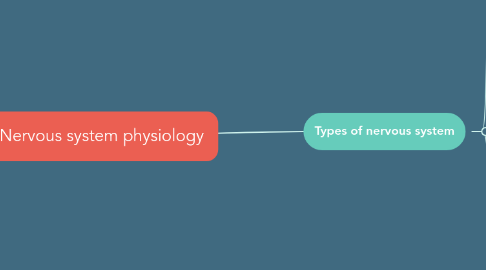
1. Unit of nervous system (neuron)
1.1. Structural unit of nervous system
1.1.1. Consisting of soma dendrites and axon Signal come to soma through dendrites Signal go from soma through axon
1.1.2. Axon and dendrites has schwaan cell cover it with myelin to generate it if it cut not in some so if it cut it die
1.1.2.1. Myelinated A (thick myelinated) delivered signal with speed of 100m/second B (thin myelinated) delivered signal with speed of 10m/second
1.1.2.2. Unmyelinated C delivered signal with speed of 1m/second Have aso schwaans cell but not acive
1.2. Functional unit of nervous system
1.2.1. Relfex arc Consisting of 5 unit Receptors to feel pain Afferent nerve to carry signal to central Central to determine type of response Then efferent to carry signal from central Then effector organ
1.2.1.1. Monosynaptic
1.2.1.1.1. If afferent connect directly to efferent fiber in spinal cord Only one action in body work on this theory Stretch effects
1.2.1.2. Polysynaptic
1.2.1.2.1. If afferent nerve connect to efferent nerve with intermediate neurones in spinal cord All action in the body
2. Types of nervous system
2.1. Central nervous system
2.1.1. Spinal cord 31 pairs spinal nerve all mixed nerves sensory and motors nerve cell from gray mater (soma) and nerve fiber from white mater
2.1.1.1. Cervical 8 pairs of nerves Thoracic 12 pairs of nerves Lumbar 5 pairs of nerves Sacral 5 pairs of nerves Coccygeal 1 pair of nerves
2.1.1.2. Gray mater have three horns White matter have three colums
2.1.1.2.1. Gray maters
2.1.1.2.2. White mater
2.1.2. Brain (cranial nerve 12 nerve) not mixed all some are sensory some are motors some are mixed Higher centers
2.1.2.1. Functions
2.1.2.1.1. Limbic cortex and hypothalamus Emotional and behaviour reflexes
2.1.2.1.2. Hypothalamus Thermostat Glucostat Appestat
2.1.2.1.3. Mid brain Response for eye controling
2.1.2.1.4. Medulla oblongata Vital center response for cardiovascular system and respiratory system
2.1.2.1.5. Sacral centers For urination ejaculation and erection
2.1.2.2. Anatomy
2.1.2.2.1. Cerebrum
2.1.2.2.2. Cerebellum
2.1.2.2.3. Brain stem
2.1.3. All nerves are somatic 31 spinal and 12 crenial except sensory nerves in cranial nerves Some of them are automatic 15 Parasympathetic and 7 crenial
2.2. Peripheral nervous system
2.2.1. Types
2.2.1.1. Somatic nervous system Volantery only for skeletal muscles Nerve come out from anterior horn cells of gray mater It's only one efferent cell from spinal to effector organ A alpha type Nerve operator Actylcholine From all Cranial nerve except sensory nerves And all spinal nerves
2.2.1.2. Autonomic nervous system Involuntary Muscles (cardiac or smooth) glands (endocrine or exocrine From lateral horn cells in 15 thoracolumbar in sympathetic nervous system and coressponding cell in remaining nerves Two efferent nerves : From spinal cord to ganglia called preganglionic nerve type B From ganglia to effector organ through 9 postganglionic nerves type C Nerve regulator Actylcholine noradrenaline
2.2.1.2.1. Autonomic ganglia
2.2.1.2.2. Types
2.2.1.2.3. Chemical transmitter of autonomic nervous system
2.2.1.2.4. Drugs
